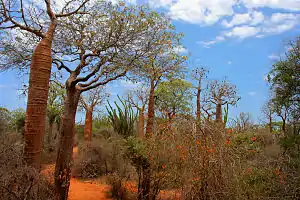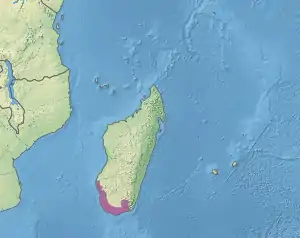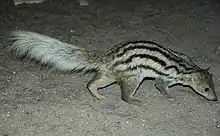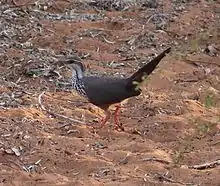Madagascar spiny forests
The Madagascar spiny forests (also known as the Madagascar spiny thickets) is an ecoregion in the southwest of Madagascar. The vegetation type is found on poor substrates with low, erratic winter rainfall. The ecoregion contains an outstanding proportion of endemic plant species and is listed as one of the 200 most important ecological regions in the world; one of the Global 200.
| Madagascar spiny forests | |
|---|---|
 Spiny forest at Ifaty, featuring various Adansonia (baobab) species, Alluaudia procera (Madagascar ocotillo) and other vegetation | |
 | |
| Ecology | |
| Realm | Afrotropic |
| Biome | Deserts and xeric shrublands |
| Borders | Madagascar succulent woodlands, Madagascar lowland forests |
| Geography | |
| Area | 43,400 km2 (16,800 sq mi) |
| Country | Madagascar |
| Elevation | 55–200 metres (180–656 ft) |
| Coordinates | 24°54′S 44°12′E |
| Geology | Limestone and red sand |
| Climate type | Hot desert climate (BWh) |
| Soil types | sandy |
| Conservation | |
| Conservation status | critical/endangered |
| Global 200 | yes |
Flora
This is the area with the highest level of plant endemism in Madagascar, with 48% of the genera and 95% of the species endemic.[1] Many constituent plants show extreme adaptations to drought. Spiny plants of the endemic subfamily Didiereoideae form a conspicuous component, especially towards the east. They are woody but distantly related to the cacti. The remaining component of the forests is dominated by members of the plant families Burseraceae, Euphorbiaceae, Anacardiaceae and Fabaceae, all of which have representatives elsewhere.[2]
Fauna
Notable inhabitants of the spiny thickets include the spider tortoise (Pyxis arachnoides) and the radiated tortoise (Astrochelys radiata), the gecko Ebenavia maintimainty, several lemurs including Verreaux's sifaka, Grandidier's mongoose, and eight endemic birds.[2]
Conservation
Existing reserves protect a maximum of 3% of the remaining vegetation, including Tsimanampetsotsa National Park, Berenty Reserve, and Beza Mahafaly Reserve. Andohahela National Park offers limited protection through its 'parcel 3' section. Elsewhere the spiny forest habitat is under pressure from human exploitation. The main impacting activities are burning for conversion to grazing land, harvesting for charcoal and firewood, and logging for construction.[2] The Arboretum d'Antsokay is a botanical garden near Toliara dedicated to preserving the flora of the spiny forest.[3]
Gallery
 The Madagascar ocotillo, Alluaudia procera, named after the unrelated ocotillo
The Madagascar ocotillo, Alluaudia procera, named after the unrelated ocotillo The bottle tree, Moringa drouhardii, found mainly in the spiny forests
The bottle tree, Moringa drouhardii, found mainly in the spiny forests A fat-tailed dwarf lemur of the spiny forests and succulent woodlands
A fat-tailed dwarf lemur of the spiny forests and succulent woodlands Verreaux's sifaka, a lemur species occurring, in part, in the spiny forests
Verreaux's sifaka, a lemur species occurring, in part, in the spiny forests A ring-tailed lemur in Berenty Reserve, set in the spiny forests ecoregion
A ring-tailed lemur in Berenty Reserve, set in the spiny forests ecoregion Grandidier's mongoose, a range-restricted carnivore of the spiny forests
Grandidier's mongoose, a range-restricted carnivore of the spiny forests The subdesert mesite, endemic to the spiny forests
The subdesert mesite, endemic to the spiny forests
References
- Elmqvist T, Pyyko ̈nen M, Tengo ̈M, Rakotondrasoa F, Rabakonandrianina E, et al (2007) Patterns of Loss and Regeneration of Tropical DryForest in Madagascar: The Social Institutional Context. PLoS ONE 2(5): e402. doi:10.1371
- Crowley, H. (2004). "113 – Madagascar Spiny Thickets". In Burgess, N.; D'Amico Hales, J.; Underwood, E.; et al. (eds.). Terrestrial Ecoregions of Africa and Madagascar: A Conservation Assessment (PDF). World Wildlife Fund Ecoregion Assessments (2nd ed.). Washington D.C.: Island Press. pp. 415–417. ISBN 978-1559633642. Archived from the original (PDF) on 2016-11-01.
- Botanic Gardens Conservation International - Arboretum d'Antsokay
External links and bibliography
- For extent, fragmentation and intact sections, see: A refined classification of the primary vegetation of Madagascar based on the underlying geology, Du Puy and Moat, 1996.
- For dominant plant families, see: Structure and floristic composition of the vegetation in the Réserve Naturelle Intégrale d’Andohahela, Madagascar, Rakotomalaza and Messmer, 1999.
- "Madagascar spiny thickets". Terrestrial Ecoregions. World Wildlife Fund.
- Madagascar spiny thickets (Encyclopedia of the Earth)